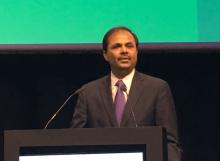MUNICH – Neoadjuvant erlotinib for patients with stage IIIA (N2) non–small cell lung cancer (NSCLC) increased progression-free survival (PFS), compared with gemcitabine and cisplatin, according to results from the recent CTONG 1103 trial.
Despite beating chemotherapy, erlotinib, an epithelial growth factor receptor (EGFR)–mutant tyrosine kinase inhibitor (TKI), fell short of benchmarks set by adjuvant therapy, so it is unlikely that neoadjuvant erlotinib will see clinical use anytime soon.
Lead author Wen-Zhao Zhong, MD, PhD, of Guangdong Lung Cancer Institute and Guangdong General Hospital in Guangzhou, China, presenting at the European Society for Medical Oncology Congress, said that the recent findings support further investigation into biomarker-guided neoadjuvant therapy for stage IIIA (N2) NSCLC, as identifying patient subgroups could potentially improve outcomes.
Principal investigator Yi-Long Wu, MD, described the impetus for CTONG 1103 in an interview. “Recently, the CTONG 1104 trial showed for the first time that adjuvant EGFR-TKI gefitinib could improve disease-free survival ... compared to adjuvant chemotherapy ... in N1N2-resected NSCLC. This raises the possibility that EGFR-TKIs may play a beneficial role in the neoadjuvant setting for this subgroup,” he said.
CTONG 1103 is an ongoing, phase 2, open-label trial. Out of 386 patients screened, 72 were enrolled based on treatment naivety and EGFR mutation positivity (exon 19 or 21). Following randomization, patients received either erlotinib 150 mg daily for 42 days or gemcitabine 1,250 mg/m2 (days 1 and 8) and cisplatin 75 mg/m2 (day 1) every 3 weeks for two cycles. After surgery, patients in the erlotinib group continued therapy for 1 year, while patients in the chemotherapy cohort received two more cycles of treatment.
The primary endpoint was objective response rate, and secondary endpoints included PFS, pathological lymph node downstaging, overall survival, safety measures, and complete pathological response. The investigators also highlighted major pathological response (less than 10% viable cancer cells after preoperative therapy).
The results showed that about half of the patients receiving erlotinib had an objective response (54.1%), compared with approximately one-third in the chemotherapy group (34.3%); however, this difference was not statistically significant (P = .092). Erlotinib also provided a median PFS nearly twice that of chemotherapy (21.5 months vs. 11.9 months; P = .003) and more frequent lymph node downstaging (10.8% vs. 2.9%), but no patients achieved complete pathological response. The number of patients achieving major pathological response with erlotinib was limited but still more than chemotherapy (10.7% vs. 0%). The investigators are awaiting an overall survival rate.
Erlotinib showed similar adverse events to previous trials, most commonly, rash, diarrhea, cough, and oral ulcers, compared with chemotherapy, which was associated with GI issues, hematologic disturbances, and fatigue.
In response to these findings, Suresh S. Ramalingam, MD, invited discussant and deputy director of the Winship Cancer Institute of Emory University, Atlanta, first discussed relevant efficacy measures. “The best predictor of long-term outcomes in these patients is nodal downstaging,” Dr. Ramalingam said. In previous studies, “patients who had clearance of the nodes had the best outcomes, and that continues to be an important prognostic marker.”
While major pathological response is valuable, and previous studies have revealed prognostic value, evidence is too limited to suggest that this is equivalent with cure, and it should not be considered as significant as complete pathological response, he said.
Considering that “only 11% of the patients” treated with erlotinib had nodal downstaging and/or major pathological response, and none achieved complete pathological response, Dr. Ramalingam suggested that the results were modest at best.
“While erlotinib seems to be doing better than chemo, I feel that the chemo group here is underperforming, compared to historical controls,” Dr. Ramalingam said, noting higher benchmark objective response rates (61% vs. 34%) and complete pathological response rates (4% vs. 0%).
Instead of focusing on neoadjuvant studies, Dr. Ramalingam suggested that ongoing adjuvant trials (ALCHEMIST and ADAURA) hold more promise and are more likely to serve as inroads for TKIs like erlotinib.
“Adjuvant care has withstood the test of time,” Dr. Ramalingam said. “Neoadjuvant EGFR-TKI in N2 disease I don’t think is ready for center stage.”
CTONG 1103 was sponsored by CTONG and Roche. The authors reported financial affiliations with AstraZeneca, Pfizer, Roche, and others. Dr. Ramalingam reported compensation from Amgen, Bristol-Myers Squibb, Loxo Oncology, and others.









